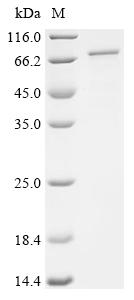The recombinant human polyamine deacetylase HDAC10 is co-expressed with the N-terminal 6xHis-tag in E.coli. Its expression region corresponds to the 1-669aa of the human HDAC10 protein. It is subjected to Ni column affinity chromatography purification. Its purity exceeds 85% as determined by SDS-PAGE.
HDAC10 is crucial for various biological processes, including transcriptional regulation, cell cycle development, hormone regulation, lipid metabolism, and autophagy [1][2]. HDAC10 promotes gene transcription repression by forming a protein complex with nuclear receptor co-repressor (NCOR) proteins [3]. Recent studies have highlighted the significance of HDAC10 in different diseases, such as cancer. HDAC10 has been implicated in promoting cancer progression and resistance to therapy [4]. HDAC10 is linked to angiogenesis in endothelial cells through specific signaling pathways [5]. Furthermore, HDAC10 also regulates the cell cycle G2/M phase transition through specific molecular pathways [6].
References:
[1] I. Oehme, J. Linke, B. Böck, T. Milde, M. Lodrini, B. Hartensteinet al., Histone deacetylase 10 promotes autophagy-mediated cell survival, Proceedings of the National Academy of Sciences, vol. 110, no. 28, 2013. https://doi.org/10.1073/pnas.1300113110
[2] Y. Xiang, Myeloid-specific hdac10 deletion protects against lps-induced acute lung injury via p62 acetylation at lysine 165, Respiratory Research, vol. 25, no. 1, 2024. https://doi.org/10.1186/s12931-024-02891-2
[3] X. Jin, Y. Yan, D. Wang, D. Ding, T. Ma, Z. Yeet al., Dub3 promotes bet inhibitor resistance and cancer progression by deubiquitinating brd4, Molecular Cell, vol. 71, no. 4, p. 592-605.e4, 2018. https://doi.org/10.1016/j.molcel.2018.06.036
[4] Y. Li, X. Zhang, S. Zhu, E. Dejene, W. Peng, A. Sepulvedaet al., Hdac10 regulates cancer stem-like cell properties in kras-driven lung adenocarcinoma, Cancer Research, vol. 80, no. 16, p. 3265-3278, 2020. https://doi.org/10.1158/0008-5472.can-19-3613
[5] B. Duan, D. Ye, S. Zhu, W. Jia, C. Lu, G. Wanget al., Hdac10 promotes angiogenesis in endothelial cells through the ptpn22/erk axis, Oncotarget, vol. 8, no. 37, p. 61338-61349, 2017. https://doi.org/10.18632/oncotarget.18130
[6] Y. Li, L. Peng, & E. Seto, Histone deacetylase 10 regulates the cell cycle g2/m phase transition via a novel let-7–hmga2–cyclin a2 pathway, Molecular and Cellular Biology, vol. 35, no. 20, p. 3547-3565, 2015. https://doi.org/10.1128/mcb.00400-15




